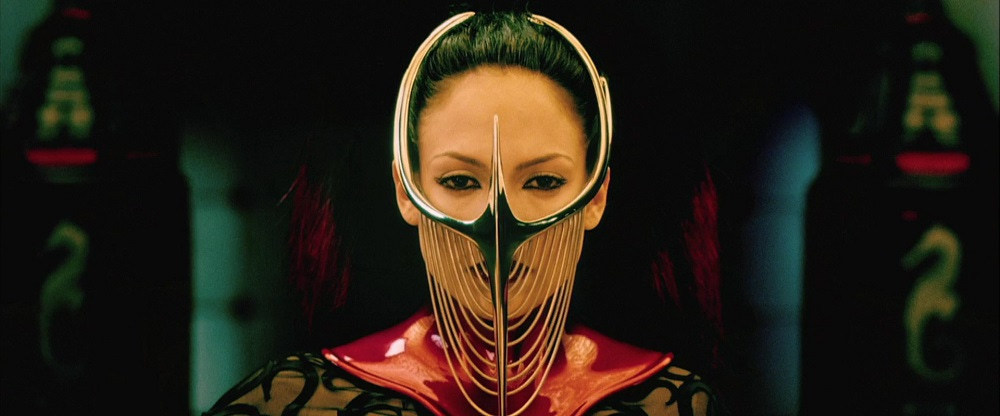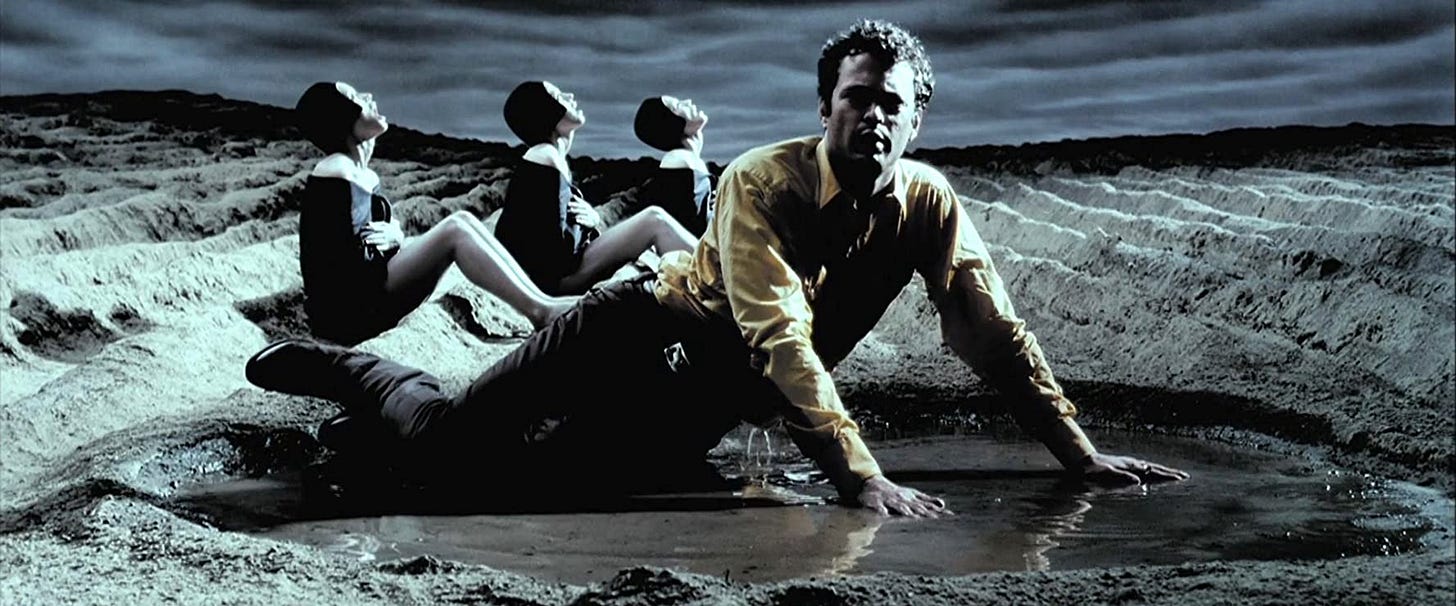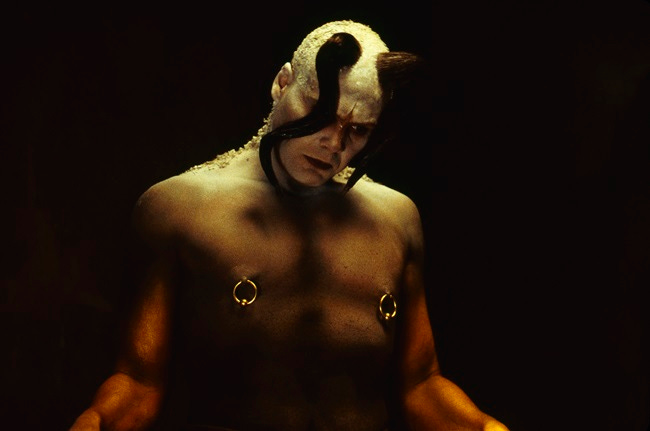SERIAL KILLER GOES TO ART SCHOOL
We revisit the first DVD we ever watched, Tarsem Singh’s The Cell
You don’t often get much say in your first encounter with a media format, but mine have tended to be solid bangers. First movie watched on broadcast? The Wizard of Oz. First cassette tape purchased? The Repo Man soundtrack. First VHS watch? Psycho. First streaming video? Exploding Whale. First DVD watched? The Cell.
Record scratch: that one has always felt like a bit of let down. But why?
The Cell is the story of a child psychiatrist played by Jennifer Lopez—then at peak J. Lo fame—who enters the mind of a serial killer using something-something technology. The Cell was critically reviled on release in 2000 for both its empathetic approach to serial killers, and former music video director Singh’s wholesale plundering of art history for his ravishing visual pallet. On viewing it again nearly 24 years later it’s easy to see those are in fact the strengths of The Cell. As well, it led Emily to talk about her mixed feelings about her upcoming novel, her first to ever deal with the subject of serial killing. —Brian J Davis
EMILY SCHULTZ: What I remember about watching this on DVD was thinking, This technology won’t stick around.
BRIAN J DAVIS: The more that we’ve talked about The Cell, the more I realize though I may have seen this once, just starting my art carer, this sent me on my digital journey. I want to know what they’re doing in this movie visually and how they’re doing it. The digital intermediate, the bleach bypass.
ES: It’s interesting that this was both our first DVD.
BJD: It wasn’t our choice! It was over Christmas at my brother’s place and he was showing off his DVD player. I think the choice was this or Blade. We hadn’t seen this in theater. I remember the reviews were atrocious. How dare you try to make me empathize with a serial killer?
ES: That doesn’t bode well for me.
BJD: Because you just finished your new novel, which is a first-person narrative. But here’s the important part, it is a female serial killer.
ES: And we’re yet to discover how the public will take that.
BJD: I think with a female serial killer, even though our culture does judge female criminals harsher, some might just say, maybe she had her reasons. Okay, you have pointed out this might be the most goddamn ’90s movie of all time, despite being from 2000.
ES: I’m sure the pitch was like: “It’s the Matrix meets Seven!”
BJD: The interesting thing is The Matrix was able to invent a decade: the entirety of the aughts was Matrix-y. And The Cell is instead looking back—it’s the culmination of all things 1990s with the transgressive art references of Damien Hirst, Joel-Peter Witkin, or the body art of Stelarc.
ES: Why is Kurt Cobain the serial killer?
BJD: Vincent D’Onofrio has come on-screen with his wig. It’s true, he looks like he should be asking, “You want to see my band? We’re playing at Zoot’s on Tuesday.”
ES: I’m wondering why we have not seen this movie in 24 years?
BJD: It’s a lot to take in visually. No matter how attuned you are to art references or movie references there’s too many inputs. Like this opening: A Magritte painting mixed with the movie Coma and the Eiko Ishioka costumes. It makes the brain start to work too much.
ES: And D’Onofrio is not a light-duty serial killer! My serial killer does not really engage in torture.
BJD: It’s the little things! Charm goes a long way in a serial killer. I want to take this back to you and your journey in the last year of this new novel. Do you have a moral responsibility when you’re writing about crimes like this?
ES: I mean, the serial killer book that I’m writing is not based on any actual killings. But there certainly are killings that are happening which are similar types of crimes. I think I felt more responsibility when I was writing Little Threats. Whereas I think with the new novel... The new novel is not as serious. It is much more of a burlesque through the subject. Will readers like it? It remains to be seen.
BJD: You’re going on the assumption that we like to get inside the head of evil, which is the plot of this movie! And readers might even enjoy the trip a little bit?
ES: That’s what I’m worried about with the new novel—that it is an enjoyable serial killer book. It’s also a social critique of consumerism and image.
BJD: Gotta have your greens in there.
ES: It’s a new work. I really don’t know how to talk about it yet.
BJD: I’ll tell you the one thing it isn’t. It’s not camp. And I do think that The Cell does have camp moments. The childhood flashback scenes have a certain flare of community theater to them.
ES: Here’s the thing about getting inside the head of a killer: it’s not easy to do. I was writing this, and I was still making her too emotional. And you would have a note: she doesn’t feel fear at all. That’s not one of her emotions. And it was so hard for me to separate myself from the emotions that I would feel.
BJD: This movie could be Posh Nightmare on Elm Street or Super Dark Inside Out. Now, J. Lo is smoking a joint and watching Fantastic Planet—she’s just like us!
ES: I think she’s great in this movie.
BJD: I think J. Lo was robbed of an Oscar nomination for Hustlers. Now, you pointed out that one of the big ’90s things here is the inner child stuff, right?
ES: To me it felt like this movie was really coming out of the early ’90s. When I was in therapy as a teen in the early ’90s they were talking about the inner child, and I was like, “Uh, my inner child is not that far away.”
BJD: It keeps hitting me that this was a major movie and it is almost like if Peter Greenaway directed Silence of the Lambs. An artist reminding you that you’re watching an image. And at the ending gilt even starts growing around the edge of the frame. I think Tarsem Singh is saying you can see the history of evil through art.
ES: Oh, that’s a good point.
BJD: The contemporary art world was pissed at the time, because he was swiping from living artists, especially Hirst, Witkin, and Odd Nerdrum. There’s an argument to that and there’s also an argument that in film you should just steal.
ES: And now Hank from Breaking Bad! And Vince Vaughn.
BJD: You said you actually had some Vaughn dissonance watching this time?
ES: To see him in this dramatic role. I forgot!
BJD: You forgot that Vince Vaughn started out as a very serious actor. And he’s quite good, right? He’s from the Thomas Harris tradition of the profiler who might be just as off as the killer. It’s kind of interesting that they do away with an entire procedural in the first act. And now they’re inside the visual articulation of the killer’s mind!
ES: I wish it wasn’t a Marilyn Manson video.
BJD: You’re taking one of the worst examples of 1990s transgressive. Think of the best examples. Joel-Peter Witkin’s photographs are extraordinary. Impossible to look at and impossible to look away from. They’re painful arguments about beauty.
ES: I just think there’s sexy bondage and there’s creepy bondage!
BJD: There’s a lot of gratuitous cruelty in this movie. And it’s matched by a lot of gratuitously saccharine moments.
ES: Do you think they were trying to strike a balance?
BJD: When you have such extremes you can’t quite recover from either the cruel or the saccharine moments. It is an attempt to say something. Not many movies try like The Cell tried.
ES: Really wonderful, well done scene here between J. Lo and Vince. And they’re having the argument the audience is having. Can you sympathize with who a killer was before they were a killer?
BJD: Readers! I recommend putting that into your scripts: whatever you think the audience’s question or arguments would be. It’ll always add another week to your box office! Okay, now some jokes. I think there was a missed opportunity when they could have put the serial killer’s dog into the mind-jumping machine.
ES: Maybe the dog knows where the final victim is! Look at that good boy. He’d be so honest about it!
BJD: Okay, now to talk about some of the filmmaking techniques that I nerded out on at the time. Watching The Cell now it’s like an elegy for what CGI could have been. It could have been art, but we went literal, with flying superheroes and destroyed cities.
ES: The gorgeousness of this movie, it really does contrast with the harder scenes.
BJD: Like the nipple piercings being ripped out by J. Lo during the fight? I felt that!
ES: Don’t tell that story! [Emily makes grossed out sounds.]
BJD: I have to. What no one tells you is that there is a high rejection rate for pierced nipples. Like a year in, my body decided, Nope! and starting pushing the ring out, like a Rob Bottin effect.
ES: I think my take away from The Cell is we need to be able to empathize enough to be able to watch it, but we don’t want to really empathize with the killer.
BJD: Empathy is such an important emotion as a human being, as a viewer, as an artist. But empathy is not the same as forgiveness.
ES: You think that the movie was asking us to actually forgive him?
BJD: I feel like this movie truly had—and I say this not as a compliment—a Christian ending. This movie’s like the moral opposite of Seven. Seven is like: no one can be saved. This movie is: everyone can be saved, even the serial killer. That’s not a place I could ever be at.
ES: Not in this scenario, no! And maybe that’s the limits of empathy. Empathy is important. Forgiveness, optional. I don’t ask the reader to forgive my serial killer. In fact, I tell the reader she’s going to stay more or less the same. Sorry. Spoiler.
BJD: So let’s hope people appreciate consistency.
ES: I will hope so!
The Cell is now available in a new 4K edition from Arrow Video







I never saw The Cell and this post made me want to. I was too influenced by the bad reviews when it came out. (Also very much looking forward to the new novel, I think “from the perspective of a female serial killer” is exactly the vibe I’m after right now.)